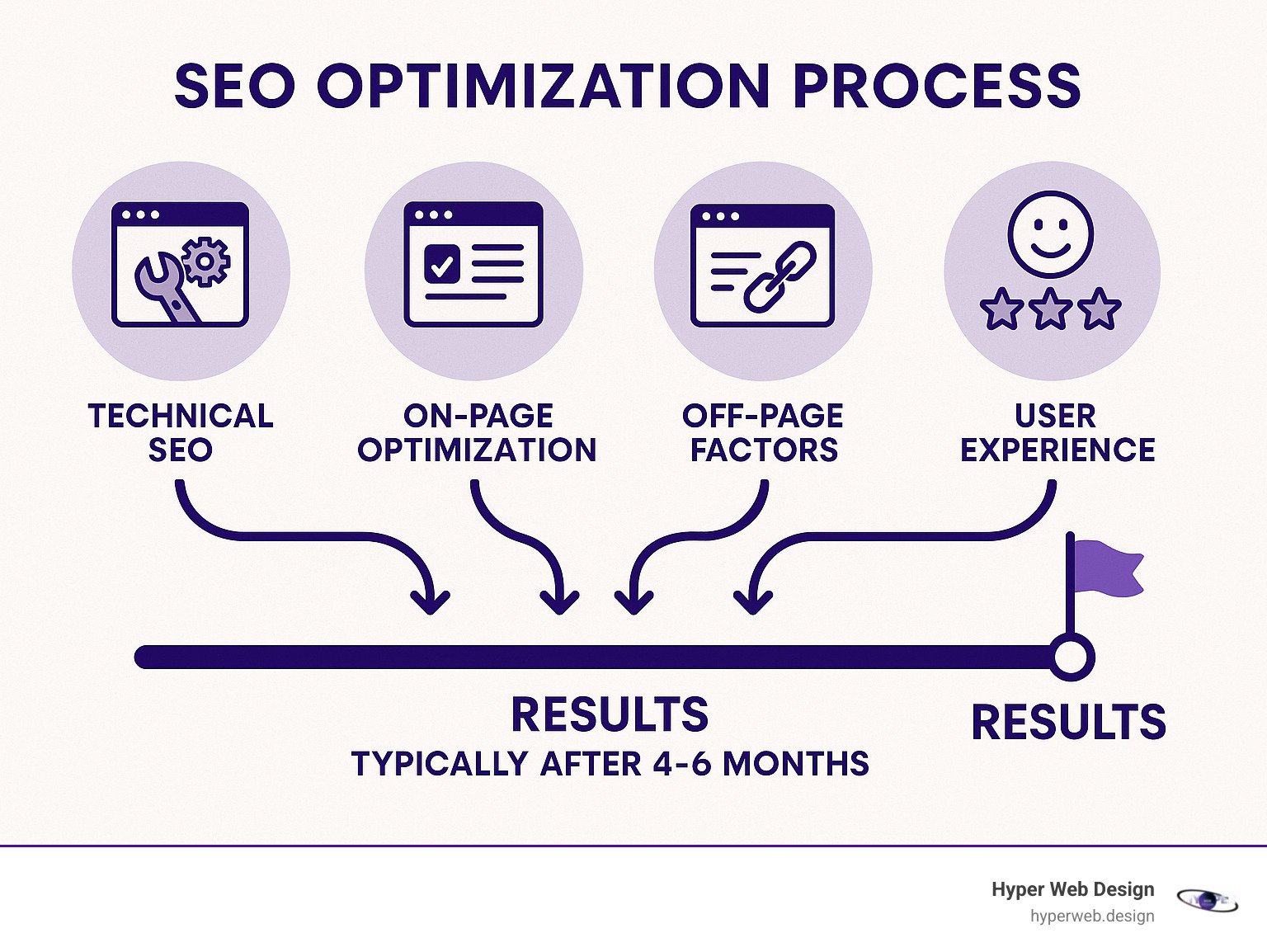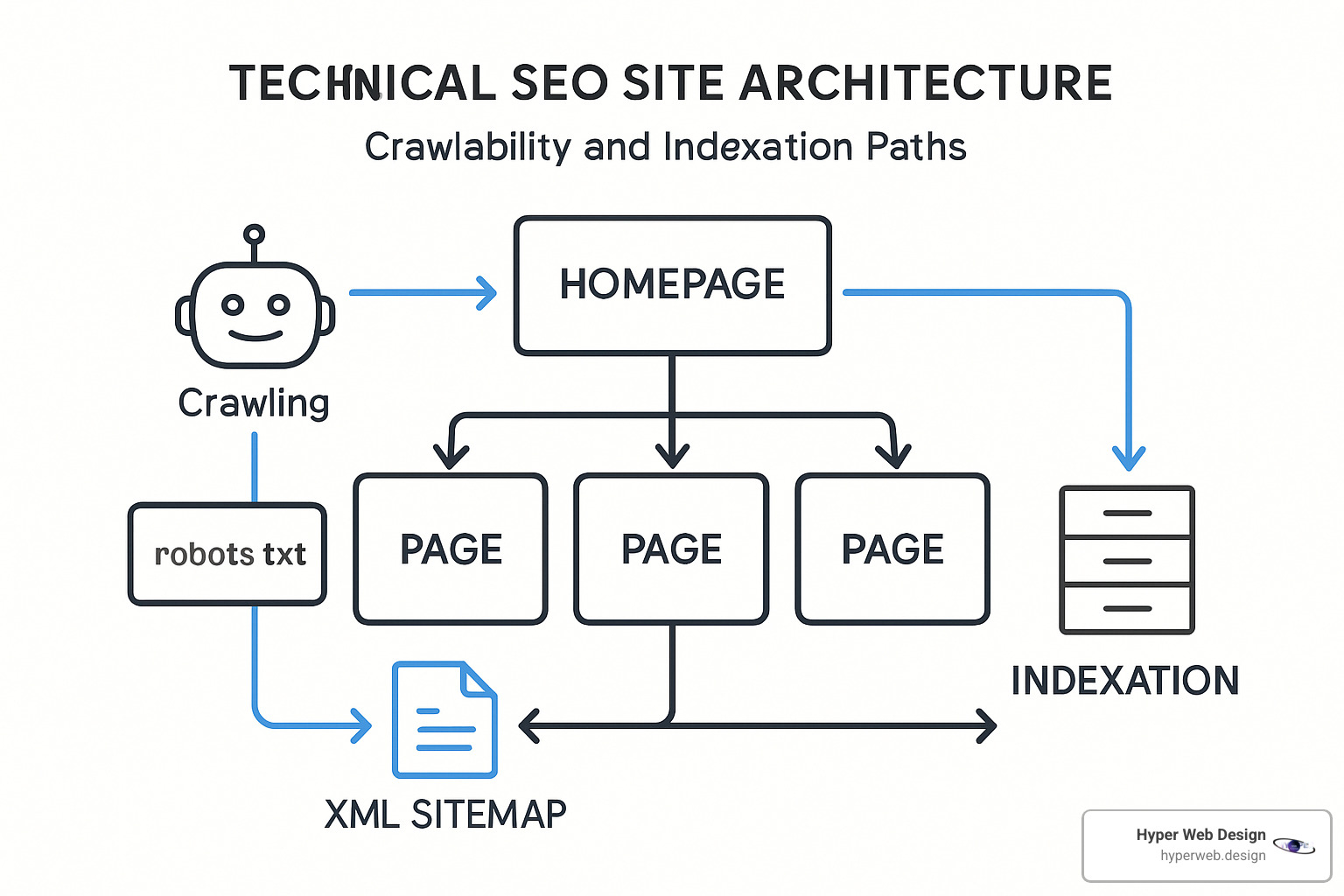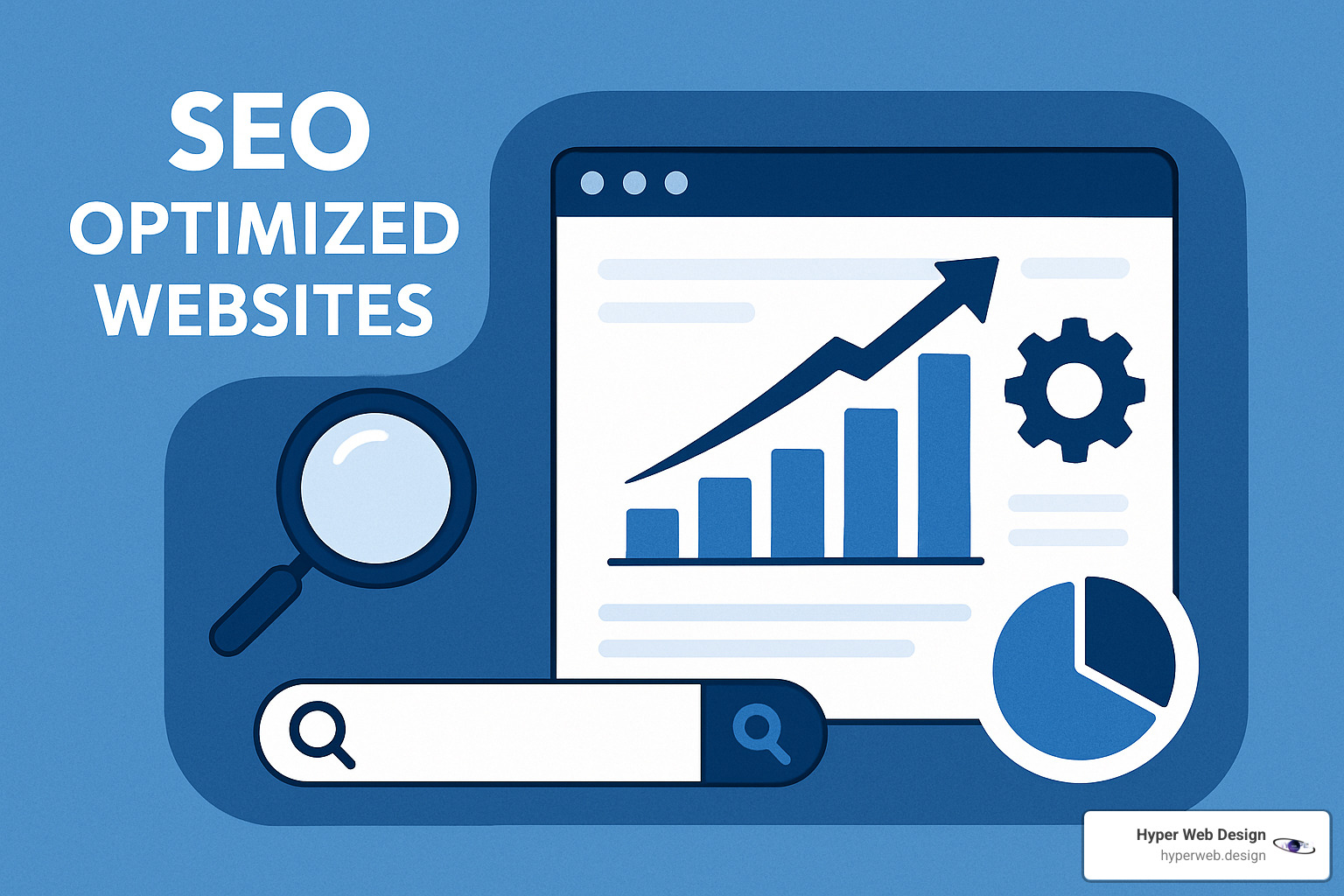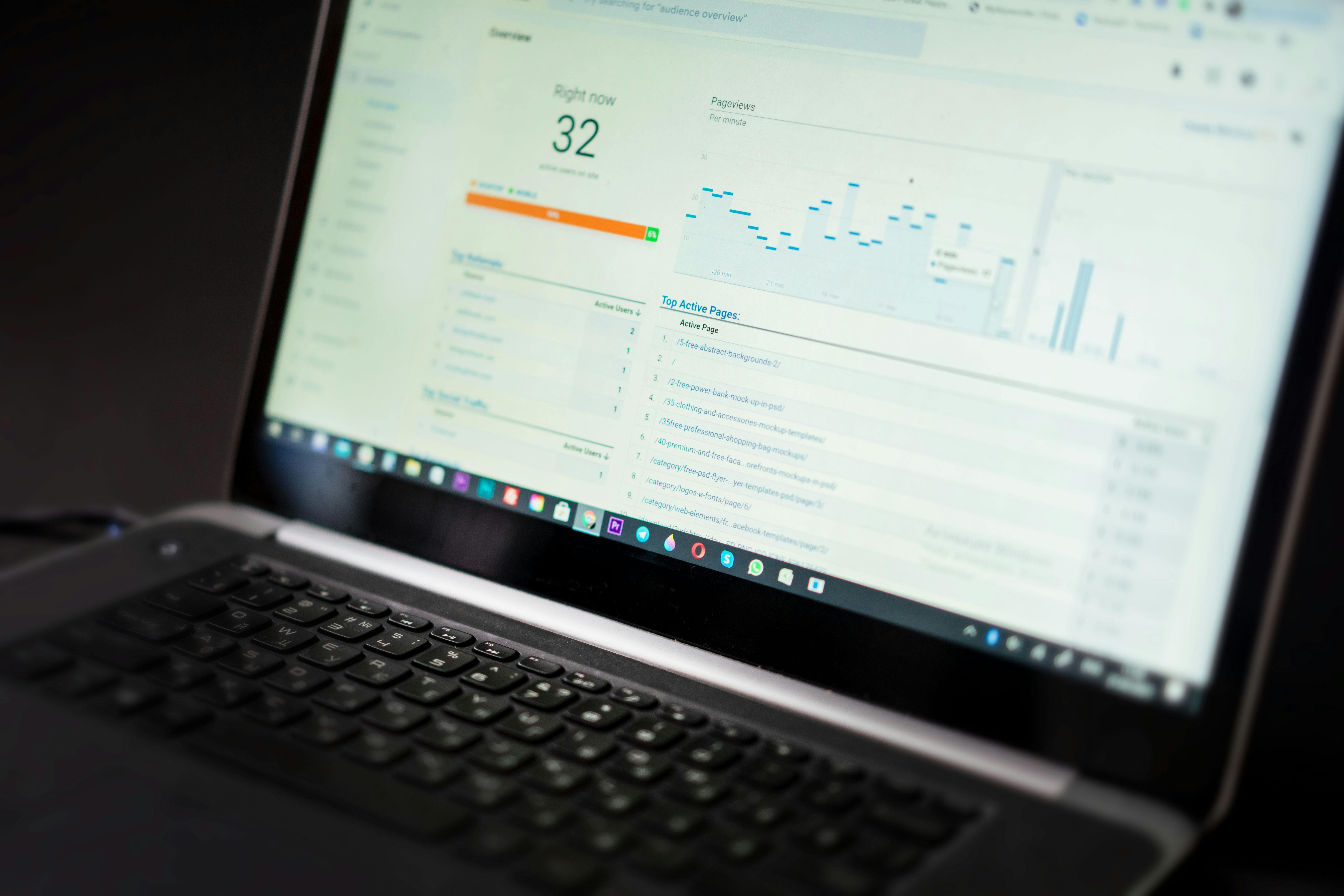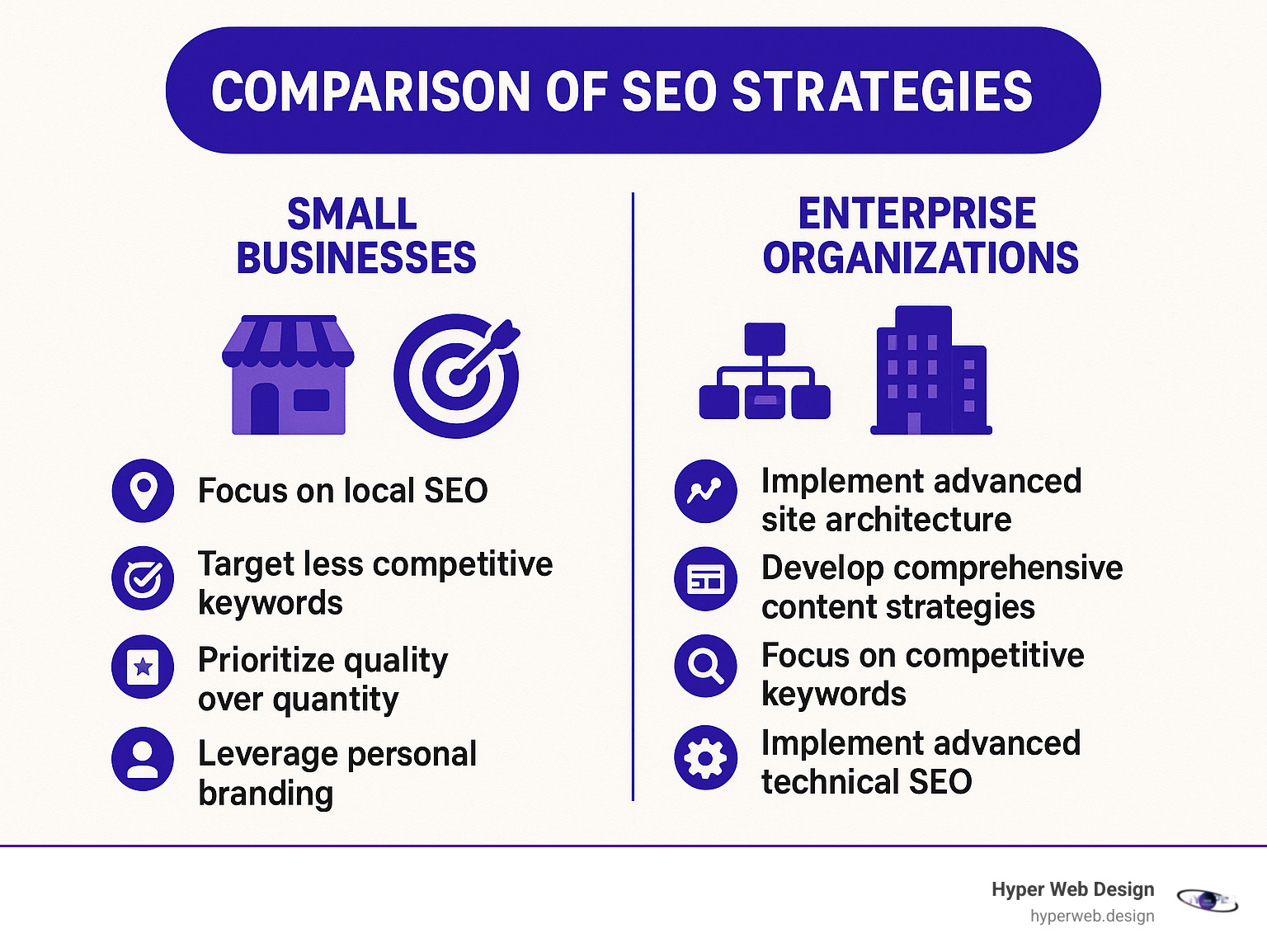The Path to Digital Visibility: Why SEO Matters
SEO optimized websites are essential for businesses looking to increase their online visibility and attract qualified traffic. If you’re searching for a way to improve your website’s performance in search engines, here’s what you need to know:
What makes a website SEO optimized:
- Technical foundation – Fast loading, mobile-friendly, secure (HTTPS)
- Content quality – Relevant, valuable information that matches search intent
- On-page elements – Proper headers, meta descriptions, and keyword usage
- User experience – Easy navigation and low bounce rates
- Backlink profile – Quality links from reputable websites
Did you know that organic search delivers 53% of all website traffic? This makes search engine optimization not just a nice-to-have, but a critical component of your digital presence. When implemented correctly, SEO helps your luxury brand stand out in a crowded digital landscape and connect with your ideal customers at the exact moment they’re searching for what you offer.
“There are no secrets here that’ll automatically rank your site first in Google,” as Google’s own SEO Starter Guide states. SEO is a methodical process that combines technical excellence, quality content, and strategic promotion.
For luxury brands, an SEO optimized website does more than just improve rankings—it creates a digital experience that reflects your brand’s exclusivity and attention to detail. From page speed to structured data, every element works together to create a website that both search engines and users love.
I’m Shawn Shameli, and for over a decade, I’ve helped luxury brands create SEO optimized websites that not only rank well but also deliver exceptional user experiences that convert visitors into customers. My approach combines technical precision with creative design to ensure your digital presence matches the sophistication of your brand.
Understanding SEO: The Foundation of Every High-Ranking Site
Let’s talk about what makes SEO optimized websites tick. Think of SEO as the invisible force that helps people find you in the vast digital universe. Every day, Google processes over 8.5 billion searches from people looking for answers, products, and services. Your goal? Be there when they’re looking for what you offer.
Search engines work like librarians organizing the world’s biggest library. They follow a three-step process that determines whether your website gets finded:
First, search engines crawl your site by sending little digital robots to explore your content, following links from page to page like breadcrumbs. Then comes indexing, where they process what they’ve found and store it in their massive database. Finally, when someone searches, ranking kicks in – the search engine decides which pages deserve to be shown based on hundreds of factors including relevance and authority.
According to research from Statista, Google dominates the search landscape with a whopping 91% global market share. While other search engines exist, focusing your optimization efforts on Google’s guidelines typically gives you the best return on investment.
But here’s what many miss: SEO isn’t just about climbing to the top of rankings. It’s about connecting with real people who are actively looking for solutions. This is where understanding search intent becomes your secret weapon.
Every time someone types something into Google, they have a specific purpose in mind. They might be seeking information (“how to create an SEO friendly website”), looking for a specific site (“Hyper Web Design Houston”), ready to make a purchase (“hire web designer in Texas”), or researching before buying (“best SEO web design companies”). When your content aligns perfectly with these intentions, magic happens – you attract visitors who are already interested in what you offer.
On-Page vs. Off-Page vs. Technical
Creating truly SEO optimized websites requires mastering three distinct but interconnected areas of optimization:
On-Page SEO is like setting up your store for customers. It’s about making individual pages irresistible to both search engines and humans. This means creating content that genuinely answers questions your audience is asking. It involves strategically placing keywords in titles, headers, and throughout your content – not stuffing them everywhere, but using them naturally. Your meta descriptions should be compelling 150-160 character “advertisements” that entice clicks. Proper heading structure (H1-H6) helps both readers and search engines understand your content’s organization, while thoughtful internal linking guides visitors through your site and distributes authority between pages.
Off-Page SEO is your reputation in the digital neighborhood. It’s everything that happens outside your website that signals your trustworthiness and authority. The cornerstone here is earning quality backlinks – when other reputable sites link to yours, search engines see it as a vote of confidence. This happens naturally when you create share-worthy content, manage your local citations in directories, engage on social media, and occasionally contribute guest posts to relevant industry blogs.
Technical SEO is the foundation everything else sits on. If your site isn’t technically sound, even the best content won’t perform well. This includes making sure your pages load quickly (ideally under 2-3 seconds), your site works beautifully on mobile devices, you have secure HTTPS implementation, properly configured XML sitemaps and robots.txt files, structured data markup to help search engines understand your content, and a logical URL structure and site architecture.
At Hyper Web Design, we’ve learned that the most successful SEO optimized websites don’t excel in just one area – they thoughtfully balance all three. Think of it as a three-legged stool; neglect any leg, and the whole thing topples over.
Why SEO Takes Time (But Pays Off)
“When will I start seeing results?” It’s the question on every client’s mind, and I wish I could say “tomorrow!” But the truth is more nuanced – and ultimately more rewarding.
SEO is less like a sprint and more like training for a marathon. Here’s what a realistic timeline looks like:
In the first 4-6 months, you’ll begin seeing increases in search impressions – this means your site is showing up more often, even if people aren’t clicking yet. By months 6-12, you should notice meaningful improvements in rankings and traffic as your optimization efforts gain traction. After 12+ months of consistent work, that’s when the magic happens – significant ROI and a genuine competitive advantage in your space.
Why does this journey take patience? Several factors come into play. Search engines need time to find and process changes to your website. Building authority through quality backlinks happens gradually as you earn trust in your industry. Your content needs time to mature as search engines assess how users interact with it. Algorithm updates can temporarily shuffle the deck. And in competitive niches, breaking through requires sustained effort.
But here’s the beautiful part – while SEO requires patience, it delivers compounding returns that paid advertising simply can’t match. Once you’ve established strong rankings with SEO optimized websites, you’ll continue receiving qualified traffic without paying per click. When you turn off paid ads, the traffic stops immediately. When you invest in SEO, you’re building an asset that continues working for you day and night.
Industry data consistently shows SEO delivering the highest ROI among marketing channels for many businesses. It’s like the difference between renting and owning – paid ads rent visibility, while SEO builds equity in your digital presence.
Blueprint for SEO Optimized Websites
Creating an SEO optimized website isn’t about following a rigid formula—it’s about building a digital home that welcomes both search engines and real people. Think of it as constructing a house where every element serves both form and function. Here’s our proven approach to developing websites that rank well and convert visitors into loyal customers:
Keyword Research & Implementation
Think of keywords as the foundation of your digital home. Without understanding the language your potential customers use, you’re essentially building in the dark.
Start with your primary keywords—these are the terms directly connected to what you offer. If you run a luxury jewelry store in Miami, your primary keywords might be “custom jewelry design Miami” or “high-end jeweler Florida.”
From there, expand your vision:
Long-tail keywords are like detailed conversations with potential customers. Instead of just “wedding rings,” think “vintage-inspired platinum wedding bands with sapphires.” These phrases often have lower competition but higher conversion rates because they’re so specific.
Semantic keywords help search engines understand context. If you sell luxury watches, related terms might include “timepieces,” “chronographs,” or “Swiss-made movements.”
Questions reveal what your audience really wants to know. “How to care for a luxury watch” or “what makes a diamond high quality” can inspire content that answers real concerns.
When we work with clients at Hyper Web Design, we don’t just dump keywords onto pages. We create strategic keyword maps where every page has a clear purpose, targeting terms that align with both search volume and business goals. This thoughtful approach ensures your content feels natural while still signaling relevance to search engines.
Technical Excellence for SEO Optimized Websites
The technical foundation of your website is like the electrical and plumbing systems in a luxury home—invisible to casual visitors but absolutely essential for functionality.
Mobile-First Design isn’t optional anymore. With over 63% of web traffic coming from mobile devices, Google primarily uses your site’s mobile version for ranking. A truly responsive design adapts beautifully to all screen sizes, with touch-friendly navigation and perfectly readable text without zooming.
Site Speed directly impacts both rankings and user experience. When a page takes more than 3 seconds to load, nearly a third of visitors will leave immediately. We optimize images, implement browser caching, and minimize code to ensure your pages load lightning-fast on all devices.
Security isn’t just about protection—it’s about trust. HTTPS encryption (that little padlock in the browser) safeguards user data and is a confirmed Google ranking factor. At Hyper Web Design, we would never launch a site without proper security protocols.
Structured Data Markup helps search engines understand your content on a deeper level. This behind-the-scenes code can transform your search listings into rich snippets that stand out, potentially improving click-through rates by up to 30%.
Your site also needs proper navigation aids for search engines. An XML Sitemap acts like a detailed map of your digital property, while your Robots.txt file tells search crawlers which areas to explore or avoid.
Our development team at Hyper Web Design specializes in creating technically flawless websites that provide the perfect foundation for SEO success. Our Responsive Website Design service ensures your site performs beautifully across all devices.
Content That Ranks & Converts
Content is the soul of any SEO optimized website. It’s what transforms visitors into customers and casual browsers into loyal fans. But creating content that both ranks and converts requires strategic thinking.
People-First Content Strategy
Google’s algorithms have become increasingly sophisticated at recognizing content that genuinely helps people. This isn’t about tricks—it’s about creating value. Write comprehensive, authoritative content that fully addresses what your visitors want to know. Use a clear, engaging style that feels like a conversation, not a lecture. Organize information logically with proper headings that guide readers through your content.
The concept of E-E-A-T (Experience, Expertise, Authoritativeness, and Trustworthiness) has become central to Google’s evaluation of content quality. Show your credentials, back up claims with data, and demonstrate real-world experience with your subject matter.
Content Silos for Topical Authority
Think of your content like neighborhoods in a well-planned city. When you organize related content into thematic clusters or “silos,” you help search engines understand your areas of expertise.
For example, a luxury interior design firm might create separate content neighborhoods for “Contemporary Home Design,” “Luxury Kitchen Renovations,” and “Custom Furniture Selection.” Each neighborhood has a main street (pillar page) with smaller streets (subtopic pages) branching off, all connected through thoughtful internal linking.
Content Freshness & Updates
Even the most beautiful gardens need regular tending. Similarly, your content needs regular updates to stay relevant and valuable. This doesn’t mean constantly creating new pages—updating existing content is equally valuable and often more efficient.
Schedule regular content reviews to identify outdated information, refresh statistics and examples, and add new sections that address emerging questions in your field. When you make significant updates, be sure to update publication dates to signal freshness to both readers and search engines.
Multimedia Improvement
Words are powerful, but combining them with visual elements creates a richer experience. High-quality images with descriptive alt text not only make your content more engaging but also provide additional SEO opportunities. Consider adding infographics that visualize complex concepts, videos that demonstrate products or services, and interactive elements that increase time on page.
At Hyper Web Design, we develop content strategies that align with both search requirements and your brand’s unique voice. We don’t just aim for rankings—we create content that converts visitors into customers by clearly communicating your unique value proposition.
Media Optimization & Link Strategy
While text content forms the backbone of SEO optimized websites, the right multimedia elements and smart linking strategy can take your site from good to exceptional. Let’s explore how to make your visual content work harder for your SEO while building authority the right way.
Optimizing Images & Videos for SEO Optimized Websites
Have you ever abandoned a website because images took forever to load? You’re not alone. Visual content dramatically boosts engagement, but without proper optimization, those beautiful images and videos can actually hurt your SEO by slowing down your site and missing valuable ranking opportunities.
For images, start with the basics: choose the right format for each situation. WebP offers excellent compression for web graphics (with JPEG/PNG fallbacks for older browsers), while SVG is perfect for logos and icons that need to scale. Always compress without sacrificing quality—aim to keep file sizes under 200KB when possible.
Remember to give your images descriptive filenames instead of the default camera output. “luxury-kitchen-design-houston.jpg” tells search engines far more than “IMG_12345.jpg” ever could. Similarly, meaningful alt text serves double duty by helping both search engines understand your images and making your site accessible to visitors using screen readers.
When it comes to video, you’re sitting on SEO gold. According to research from BrightEdge, websites with optimized videos are 53 times more likely to reach Google’s first page, and video now accounts for a staggering 82% of all internet traffic. But to harness this power, you need to be strategic.
Consider both YouTube (for reach and findability) and self-hosting (for control and branding) depending on your goals. Always create compelling thumbnails that encourage clicks and include transcripts and captions to improve accessibility while providing search engines with indexable content.
Don’t forget to implement schema markup using VideoObject schema to improve your search visibility. This structured data helps search engines understand exactly what your video contains, potentially earning you those coveted rich snippets in search results.
Building Authority Without Spam
Link building remains one of the most powerful—and often most misunderstood—aspects of creating SEO optimized websites. Think of links as “votes of confidence” from one site to another. But just like in real elections, quality votes from respected sources matter far more than quantity.
The days of spammy link schemes are long gone. Today’s successful link building is about earning authority through value. Content-driven link acquisition works because it gives other sites a genuine reason to link to you. When you create truly exceptional resources—whether comprehensive guides, original research, or helpful tools—people naturally want to reference them.
At Hyper Web Design, we’ve seen remarkable success with digital PR and outreach efforts. Building relationships with industry publications takes time, but the payoff is substantial. Responding to journalist queries through platforms like HARO (Help A Reporter Out) can land your brand mentions in high-authority publications that would be nearly impossible to approach cold.
Guest posting still works when done right. The key is to focus on quality contributions to relevant sites where your target audience already spends time. This isn’t about mass-producing thin content—it’s about sharing genuine expertise that readers (and publishers) value.
Don’t overlook the power of your internal linking strategy. While external links build your site’s authority, internal links help distribute that authority throughout your pages. Think of your website as a city, with internal links serving as the roads connecting neighborhoods. Without them, visitors (and search engines) get lost or miss important destinations entirely.
Create a logical site hierarchy with clear navigation paths. Link from your high-authority pages to important conversion pages to give them an SEO boost. And always use descriptive anchor text that includes target keywords where natural—”luxury web design services” tells both users and search engines far more than “click here.”
At Hyper Web Design, we implement sophisticated link strategies that build authority naturally over time. We focus on quality over quantity, ensuring each link contributes meaningfully to your site’s overall authority and relevance. Because when it comes to links, it’s not about having the most—it’s about having the right ones.
Measuring, Monitoring & Iterating
Creating SEO optimized websites isn’t a “set it and forget it” endeavor—it’s more like tending a garden. You plant the seeds (your content and technical optimizations), but then comes the real work: watching how things grow, making adjustments, and continuously nurturing your digital presence.
Core Tools & Dashboards
Every successful SEO strategy relies on a handful of powerful tools that help you see what’s working and what needs attention.
Google Search Console is your direct line to how Google sees your website. Think of it as getting feedback straight from the source! It shows you which search queries are bringing visitors to your site, where you’re ranking, and—perhaps most valuable—any technical issues that might be holding you back. When a client comes to us worried about a traffic drop, GSC is often the first place we look for answers.
Google Analytics 4 takes a broader view, showing you what happens after visitors arrive. I love watching how the user journey unfolds—which pages capture attention, where people spend their time, and most importantly, what actions they take that contribute to your business goals. There’s something deeply satisfying about seeing conversion numbers climb after implementing an SEO strategy.
For the technical side, tools like Lighthouse have saved us countless hours by automatically checking for issues that might affect your site’s performance. I remember one luxury client whose gorgeous image-heavy site was taking 8 seconds to load—Lighthouse helped us identify compression opportunities that cut that time in half while maintaining visual quality.
At Hyper Web Design, we build custom dashboards that bring all these insights together in one place. Our clients appreciate seeing the real business impact of their SEO investments without having to become analytics experts themselves.
When to Expect Results & How to Pivot
One of the most common questions I hear is, “When will we see results?” It’s perfectly natural to want to know when your investment will pay off. While every site is different, there’s a typical pattern to how SEO results unfold.
In those first few months, the changes often happen behind the scenes. Your site becomes more crawlable, technical issues get resolved, and you might notice more impressions in Search Console. It’s like laying the foundation of a house—not very exciting to look at yet, but absolutely essential.
By months 4-6, things start getting interesting. Traffic begins to climb, especially for those less competitive keywords. You’ll notice your click-through rates improving as your titles and descriptions get more compelling. This is when clients often call me excited because they’ve received their first lead directly from organic search.
The real magic happens after 6-12 months, when your SEO optimized website begins ranking for those valuable competitive terms. Your organic traffic becomes a reliable source of qualified leads, and you’ll find yourself less dependent on paid advertising. One of our clients saw their cost per acquisition drop by 60% after a year of consistent SEO work—that’s the kind of long-term value that makes the patience worthwhile.
Of course, not every strategy works perfectly the first time. That’s where the art of pivoting comes in. If your impressions aren’t growing after several months, we might need to revisit your keyword strategy. If people see your site in search results but aren’t clicking through, your meta descriptions might need work. The beauty of digital marketing is that we can always adjust course based on real data.
At Hyper Web Design, we believe in transparent communication about what’s working and what isn’t. We don’t just send automated reports—we explain what the numbers mean for your business and how we’re adapting our approach to maximize your results. Because ultimately, SEO isn’t about vanity metrics—it’s about creating sustainable growth for your business.
Frequently Asked Questions about SEO Optimized Websites
How long until I see SEO results?
I hear this question almost daily from our clients at Hyper Web Design, and I understand the eagerness to see a return on your investment. While I touched on timelines earlier, let me give you the full picture.
For most SEO optimized websites, you’ll start seeing the first hints of progress in Google Search Console within about a month or so. Don’t get too excited though—these are usually just increased impressions, meaning your site is appearing in search results more often, not necessarily bringing in floods of visitors yet.
The real journey typically unfolds like this:
- Around 3-4 months, you’ll notice your site climbing the rankings for those easier, less competitive keywords
- By months 4-6, you should see actual traffic increases and maybe your first SEO-driven conversions
- Between 6-12 months is when the magic happens—significant organic traffic growth and meaningful business results
Several factors can speed this up or slow it down: how established your domain is, how cutthroat your industry’s competition is, how consistently you’re publishing quality content, the technical health of your site, and how effectively you’re building authoritative backlinks.
SEO isn’t a quick fix—it’s a long-term investment. The businesses that win are the ones who stay committed and keep optimizing month after month.
What are the biggest SEO mistakes to avoid?
In my years of creating SEO optimized websites, I’ve seen businesses make the same costly mistakes over and over. Let me help you avoid them:
Neglecting your technical foundation is like building a beautiful house on quicksand. No amount of amazing content can overcome slow loading times, mobile usability problems, or indexing issues.
Keyword stuffing is so 2010—and yet I still see it happening! Cramming keywords unnaturally into your content not only fails to boost your rankings but can actually trigger Google penalties.
Misunderstanding search intent is a silent killer. You might rank for a keyword, but if your content doesn’t match what users are actually looking for, they’ll bounce right back to search results.
Many businesses fall into the quantity trap, churning out dozens of thin, shallow pages instead of creating fewer, truly valuable resources that comprehensively answer users’ questions.
Skipping basic on-page optimization—properly crafted titles, meta descriptions, headings, and internal links—is like leaving free money on the table.
I’ve seen too many sites damaged by shady link building tactics. Those quick-win backlinks from questionable sources might give you a temporary boost before triggering a penalty that tanks your entire site.
Flying blind without analytics is surprisingly common. Without tracking your performance, how can you possibly know what’s working and what needs adjustment?
Impatience kills more SEO campaigns than any algorithm update. Many businesses give up just weeks before their efforts would have started paying dividends.
Staying current with algorithm changes isn’t optional—it’s essential. Google makes hundreds of updates yearly, and what worked last year might not work today.
For local businesses, neglecting local SEO is a massive missed opportunity. Your Google Business Profile and local citations could be driving customers right to your door.
At Hyper Web Design, we build a solid foundation that avoids these pitfalls from day one, setting your website up for sustainable growth.
Do small sites need a different strategy than enterprise sites?
Absolutely! One size definitely doesn’t fit all when it comes to SEO. Your strategy should match your website’s scale and business goals. Here’s how the approaches typically differ:
For small business websites, local relevance is often your secret weapon. We emphasize optimizing your Google Business Profile, building local citations, and targeting location-specific keywords that bigger competitors might overlook. Rather than competing for impossibly competitive terms, we identify niche opportunities with lower difficulty scores that can still drive qualified traffic. With limited resources, we prioritize quality over quantity—creating fewer, more focused pieces of content that really resonate with your audience. We also leverage the personal touch that small businesses can offer, highlighting the people behind the business to build trust in ways that faceless corporations can’t. And we start with the essential technical foundations—mobile optimization, site speed, and basic schema markup—before moving to more advanced tactics.
For enterprise websites, we implement more sophisticated site architecture, creating comprehensive topic clusters and internal linking structures that help establish topical authority. With more content production capabilities, we develop strategies to produce quality content at scale across multiple topics and formats. With greater domain authority, we can focus on more competitive, higher-volume keywords that would be out of reach for smaller sites. On the technical side, we address complex issues like JavaScript rendering, international SEO, and site migrations. Perhaps most importantly, we coordinate SEO efforts across departments, aligning with broader marketing, PR, and development initiatives.
At Hyper Web Design, we don’t believe in cookie-cutter solutions. Whether you’re a boutique local business or a multi-location enterprise, we create SEO optimized websites custom to your unique situation, goals, and competitive landscape.
Conclusion
Creating SEO optimized websites isn’t just about following a technical checklist—it’s about crafting digital experiences that connect with real people at exactly the right moment. While SEO combines technical expertise, creative content, and strategic planning, its purpose remains beautifully simple: bringing your business face-to-face with the people actively searching for what you provide.
The beauty of SEO lies in its lasting value. Unlike paid ads that vanish the moment your budget runs out, a well-optimized website grows stronger over time. It’s like planting a tree that continues bearing fruit year after year, generating leads and sales with increasing efficiency as it matures.
At Hyper Web Design, we’ve seen how the right approach to SEO transforms businesses. We specialize in creating SEO optimized websites that do more than just rank well—they tell your story in a way that resonates with your ideal customers. Our Houston-based team blends luxury design sensibilities with technical SEO mastery, creating digital experiences as sophisticated as the elite brands we serve throughout Texas.
We believe rankings are just the beginning. What truly matters is attracting the right visitors—people who engage with your content and ultimately become loyal customers. That’s why our approach centers on conversion-focused design, carefully guiding visitors from their initial search query through a seamless journey that ends with meaningful action.
Whether you’re starting from scratch with a brand new website or looking to breathe new life into your existing digital presence, our team brings the expertise needed to achieve sustainable growth through thoughtful optimization.
Ready to transform your digital presence from invisible to unforgettable? Explore our SEO Marketing services or reach out today to discuss how we can help your business thrive online. In today’s digital landscape, being visible isn’t just nice to have—it’s essential for growth and staying ahead of the curve.


